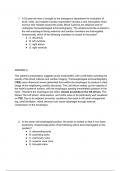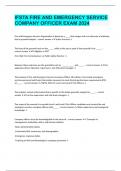1. A 52-year-old man is brought to the emergency department for evaluation of
fever, chills, and malaise.Cardiac examination reveals a new holosystolic heart
murmur that radiates toward the axilla. Blood Cultures are obtained and he
undergoes transesophageal echocardiography. The ultrasound probe is placed in
the mid-esophagus facing anteriorly and cardiac chambers are interrogated.
Anatomically, which of the following chambers is closest to the probe?
● A. left atrium
● B. left ventricle
● C. right atrium
● D. right ventricle
ANSWER A.
This patient's presentation suggests acute endocarditis, with confirmation pending the
results of the blood cultures and cardiac imaging. Transesophageal echocardiography
(TEE) uses ultrasound waves generated from within the esophagus to produce a clear
image of the neighboring cardiac structures. The Left Atrium makes up the majority of
the heart's posterior surface, with the esophagus passing immediately posterior to the
heart. Therefore,the esophagus lies within closest proximity to the left atrium. This
Allows The Left atrium, atrial septum, and mitral valve to be particularly well visualized
on TEE. Due to its adjacent proximity, conditions that result in left atrial enlargement
(eg, atrial fibrillation, mitral stenosis) can cause dysphagia through external
compression of the esophagus.
2. In the same mid-esophageal position, the probe is rotated so that it now faces
posteriorly. Anatomically,which of the following will be best interrogated in this
position?
● A. descending aorta
● B. ascending aorta
● C. pulmonary veins
● D. superior vena cava
● E. tricuspid valve
,ANSWER A.
The aorta has four major divisions: the ascending aorta, the aortic arch, the descending
thoracic aorta, and the abdominal aorta. The ascending aorta lies posterior and to the
right of the main pulmonary artery. The
aorticarchtravelsabovetherightpulmonaryarteryandtheleftbronchus. The
Brachiocephalic,left common carotid,and left subclavian arteries originate(in that
order)from its superior aspect. The Descending Thoracic aorta abuts the left anterior
surface of the vertebral column and lies posterior to the esophagus and the left atrium.
This permits clear visualization of the descending aorta during transesophageal
echocardiography (TEE), allowing for the detection of abnormalities s1Uch as dissection
or aneurysm. The descending thoracic aorta continues to travel down the left anterior
surface of the vertebral column, becoming the abdominal aorta as it crosses the
diaphragm and eventually branching into the common iliac arteries.
3. A 33-year-old man comes to the emergency department complaining of fever,
chills, and dyspnea on exertion. He admits to smoking one pack of cigarettes a
day, consuming 2-3 alcoholic beverages daily, and using intravenous illicit drugs
2-3 times per week. He is febrile and tachycardic. Blood cultures grow
Staphylococcus aureus. A diagnosis of infective endocarditis is established. The
valve most likely affected in this patient is?
● A. mitral valve
● B. tricuspid valve
● C. aortic valve
● D. pulmonic valve
ANSWER B.
Right-sided endocarditis involving the tricuspid valve commonly occurs in IV drug users
and is most often due to Staphylococcus aureus. Specifically, infective endocarditis can
cause tricuspid regurgitation, which is identified as an early systolic murmur best heard
over the left lower sternal border that is accentuated by inspiration.
Heart sounds/murmurs result from reverberation of blood secondary to valve closure.
Auscultation to determine function of a valve is performed at the position closest to
where the sound waves reverberate and not at the position of the valve.
, 4. A 54-year-old male presents to your office complaining of periodic, tight, burning
substernal chest pain. A thallium stress test shows hypoperfusion of the cardiac
muscle forming the diaphragmatic surface of the heart. Which of the following
coronary arteries is most likely occluded in this patient?
● A. left anterior descending coronary artery
● B. left circumflex coronary artery
● C. left main coronary artery
● D. right coronary artery
ANSWER D.
The right and left main coronary arteries arise directly from the root of the aorta and
provide the blood supply to the heart. The left main coronary artery divides into the left
anterior descending (LAD) and circumflex coronary arteries, which supply most of the
anterior and left lateral surfaces of the heart. In 85-90% of individuals,the right coronary
artery gives rise to the posterior descending artery. These patients are said to have right
dominant coronary circulation. In approximately 10% of patients, the posterior
descending artery arises from the circumflex branch of the left main coronary artery;
these patients have left dominant. The inferior wall of the left ventricle forms most of the
, diaphragmatic surface of the heart. This surface receives most of its blood supply by the
posterior descending artery which is directly derived from the right coronary.
5. A 34-year-old female is being evaluated for progressive exertional shortness of
breath. She has no past medical history and does not take any medications. She
does not use tobacco, alcohol or drugs. An echocardiographic study suggests
coronary sinus dilation. Which of the following best explains this finding?
● A. aortic dissection
● B. coronary artery disease
● C. hypertrophic cardiomyopathy
● D. pulmonary hypertension
ANSWER D.
The coronary sinus serves as the endpoint of venous drainage from the coronary blood
supply. Since it contains deoxygenated blood it drains into the right atrium. The coronary
sinus is usually not visible by echocardiography in most normal,healthy patients. The Most
Common Cause Of Coronary Sinus Dilatation evident on echocardiography is elevated
right-sided heart pressure secondary to pulmonary artery hypertension. Since the coronary
sinus communicates freely with the right atrium,it will become dilated by any factor that
causes dilatation of the right atrium. The coronary sinus communicates freely with the right
atrium and therefore may become dilated secondary to any factor that causes right atrial
dilatation.
6. A 54-year-old man comes to the physician for evaluation of exertional chest pain.
He undergoes coronary angiography and is found to have severe stenosis of the
right coronary artery, left anterior descending, and circumflex coronary arteries.
He is referred to a surgeon for coronary artery bypass grafting. During the
procedure, a portion of his great saphenous vein is removed and grafted to 1 of
his diseased coronary arteries to bypass its atherosclerotic narrowing. The
saphenous vein can be best harvested from which of the following sites?





